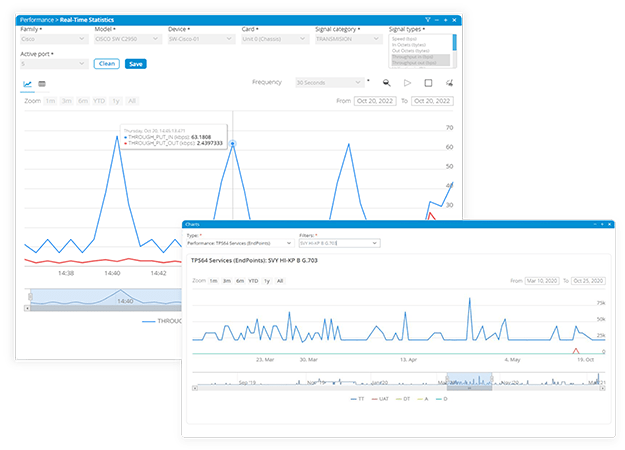30 Sep 2019
In today’s fast-paced and interconnected world, network performance management and monitoring have become vital for businesses of all sizes. By actively monitoring and measuring network performance, businesses can optimize their network’s efficiency and maximize productivity. Therefore, in this updated post, we will delve into the top 10 benefits of network performance management.
So, sit back, relax, and let’s dive into the world of network performance management!
What is Network Performance Management?
Network performance refers to the quality of service provided by a network. It’s all about how efficiently data is transmitted between devices on the network, including speed, reliability, and other factors that can affect the user experience. In other words, it’s about how well the network is functioning, and how it’s meeting the needs of its users.
Without proper management and monitoring, your network could suffer from slow speeds, poor connectivity, and even total shutdowns. Nobody wants that, right? By keeping a close eye on key metrics and addressing any potential problems, you can ensure that your network is healthy, providing a smooth and efficient user experience for all.
Get More from Your Network: Top 10 Benefits of Performance Management
1. Improve network availability
By monitoring and managing network performance, you can ensure that critical services remain available to your customers. This translates to better customer experience and higher customer retention rates. Furthermore, by optimizing network resources and bandwidth allocation, businesses can ensure that critical services are delivered with high quality of service (QoS).
2. Reduce network downtime
By providing real-time alerts and insights into network activity, network performance management enables businesses to detect and troubleshoot issues before they escalate into costly downtime or outages. This helps to minimize the impact of network issues on the business.
3. Monitor multi-vendor environment
Heterogeneous computing environments can be a real pain to manage, with applications, devices, databases, and network servers all requiring attention. That’s where network performance management comes in – it enables businesses to effortlessly monitor and manage these complex environments. With performance metrics automatically collected from servers, regardless of their location, you can rest assured that your network is running at its best.
4. Improve network scalability
As your business grows, your network needs to grow with it. Network performance management tools can help you optimize your network for scalability, network upgrades and capacity changes by providing historical data and insights into network utilization. This enables businesses to make informed decisions about scaling their network infrastructure.
5. Ensure network security
Even though it might not always come to mind, keeping an eye on your network’s performance can reveal where your resources are being utilized the most. Security attacks often drain a network’s resources, so any unusual deviation in resource usage could signify a potential security threat.
6. Support regulatory compliance
Network performance management tools help businesses across various industries ensure compliance with regulatory requirements. By tracking and monitoring network performance information, businesses can meet industry-specific regulations and avoid costly penalties.
7. Optimize bandwidth usage
With network performance management, you can easily identify bottlenecks, connectivity issues, and which devices are hogging all the bandwidth. This helps ensure quality service and proper bandwidth allocation for your critical business needs.
8. Gain insights into network performance trends
Network performance management provides historical data and insights into network performance trends, enabling businesses to identify patterns and make informed decisions about future upgrades and investments. Real-time monitoring further supports the decision-making process, allowing for better resource balancing and improved network performance.
9. Optimize Network Upgrades and Capacity
From planning end-to-end upgrades to identifying necessary capacity changes, network performance management empowers businesses to make informed decisions and stay ahead of the curve. By utilizing network performance management tools, businesses can easily decide what future purchases are necessary to improve the performance of their network, ensuring optimal performance and minimal downtime.
10. Improve efficiency and productivity by automating routine task
In today’s fast-paced business environment, automating routine tasks is essential to increase efficiency and productivity. Network performance management offers the ability to automate routine tasks such as configuration management, performance monitoring, and fault detection. This automation helps to increase overall efficiency and productivity across the organization, freeing up time for businesses to focus on other critical aspects of their operations.
What are Some Common Network Performance Issues?
Common network performance issues include:
- slow network speeds
- dropped connections
- high latency
- network congestion
- security vulnerabilities
These issues can be caused by various factors, including outdated hardware, misconfigured software, inadequate bandwidth, and cyber threats. Network performance management helps identify and address these issues, ensuring that your network runs smoothly.
What are Some Best Practices for Network Performance Management?
Some best practices for network performance management include:
- Regularly monitoring network performance metrics.
- Identifying and resolving issues promptly.
- Optimizing network configurations.
- Upgrading hardware and software.
- Implementing network security measures.
- Ensuring adequate bandwidth.
It’s also essential to regularly review your network performance management strategy to ensure that it meets your organization’s evolving needs.
Looking to monitor your network performance in real-time while also having access to historical data?

Experience real-time network performance monitoring and keep track of important metrics such as error rates and unavailability seconds. Plus, with our history statistics viewer, you’ll have access to detailed historical data to give you a long-term view of your network’s performance.
With our software, you can take advantage of the following key functionalities:
- Real-time data collection of statistics and signals from devices, cards, ports, and circuits.
- Advanced network performance reports.
- Automated routine network management tasks such as configuration management, performance monitoring, and fault detection.
Don’t let network issues go unnoticed – try SGRwin today!
